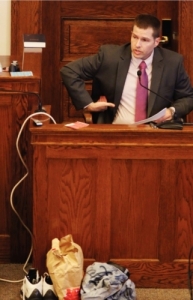Testimony continues
By John Joyce
Published in News on September 5, 2014 1:46 PM

News-Argus/MELISSA KEY
Former state medical examiner Dr. Samuel Simmons is presented with Kevin Bell's clothing as he describes the wounds found on Bell's body and possible ways he could have sustained those injuries.
Testimony resumed Thursday in the first-degree murder trial of Stephon Jennings and Javonta Ellis, the two Goldsboro teenagers the state alleges are responsible for the June 14, 2012, shooting death of 34-year-old Kevin Bell.
Assistant District Attorney Mike Ricks called several witnesses to the stand, but none of them were able to corroborate the testimony of the state's first witness, Travis James, who told the court Wednesday that he saw the shooting unfold and was holding Bell in his arms when the man took his last breath.
James said that he, Bell and another man were standing outside the victim's Slaughter Street apartment when Jennings, 19, and Ellis, 17, walked up and attempted to rob them.
Bell would end up being shot.
Dr. Samuel Simmons, a former state medical examiner who is now employed by a pharmaceutical company, said he was able to determine the cause of death -- a single gunshot wound to the arm and chest -- but that he could not specify the caliber of bullet other than to say it was of medium caliber.
He said he certainly would not be able to tell who fired it.
The medical examiner also failed to identify pills found on the victim's body -- two white pills and a yellow, powdery substance were found in the victim's pocket when the body was brought in for autopsy.
Goldsboro Police Department Crime Scene Unit Investigator Cpl. Steven Powers also took the stand.
He listed many of the items found at the crime scene, including a revolver recovered a few feet from the victim's body.
The revolver, a Taurus Judge 410/.45, is a handgun capable of firing both .45 caliber bullets and 410 shotgun shells, he said, adding that a single round had been fired from the weapon when he found it, and what appeared to be a .45 caliber bullet had been recovered from a metal screen door of an apartment across the street from where the victim's body was found.
The weapon was traced back to Bell. He purchased the gun both legally and locally and was within his rights to carry it, but neither the bullet recovered from the door nor the weapon itself were analyzed by the state lab.
And the police did not conduct gunshot residue tests on the hands of the victim, or the two men with him when he died -- Travis James, the state's first witness, and another man, Brandon Leach, who has of yet not taken the stand.
Those questions were among those raised by the defense to Powers and Simmons, both of whom could only answer that if the tests weren't ordered by the investigators, the tests would not have been conducted.
Defense attorney Charles Gurley, representing Ellis, focused on the victim's gun and how it could fire both regular caliber bullets and shotgun shells -- and about the different bullet paths the slug that struck the door could have taken.
Mary Darrow, Jennings' defense counsel, spent more time taking Powers through the crime scene photos -- asking about lighting and distance and how it might have been possible for a witness, James, to make a visual identification a day later from a photo when he had only seen the shooter in the dark at a distance and just briefly before the gun fired and the three men scattered.
James did make the identification, picking Jennings out of the second of two sets of photos presented to him by police.
The state also called Ashley Dixon to the stand.
The young woman allegedly had a sexual relationship with Jennings around the time of the shooting, but beyond that, would not answer any of Ricks' questions.
She said she had sexual contact with Jennings, but could not recall when.
She said she could not comment on whether or not she was with him on the night of the murder because she did not know when the murder took place.
And despite the fact that Ricks reminded her that they met in the D.A.'s office roughly a week ago -- and according to him, she remembered everything perfectly at that time -- Ms. Dixon did not relent.
Gurley used his cross-examination to attack different aspects of the state's case.
"How is this a robbery, or an attempted robbery, if they found everything?" he asked more than once.
While the state wrestled with its own witnesses, the defense sought to point out holes in its case -- all the while, dealing with the additional burden of having two lawyers representing their clients separately.
"It takes more effort. It is more difficult to coordinate as you go along," Ms. Darrow said during a break. "Both sides have to hope there is no conflict, as sometimes there can be as things progress."
When asked if any such conflicts had arisen so far in this particular case, Ms. Darrow said there had not.
Testimony will not resume until Monday due to a scheduling conflict with the court today.
The state will continue to call witnesses until it rests its case, at which time each defense attorney will put on their case.
